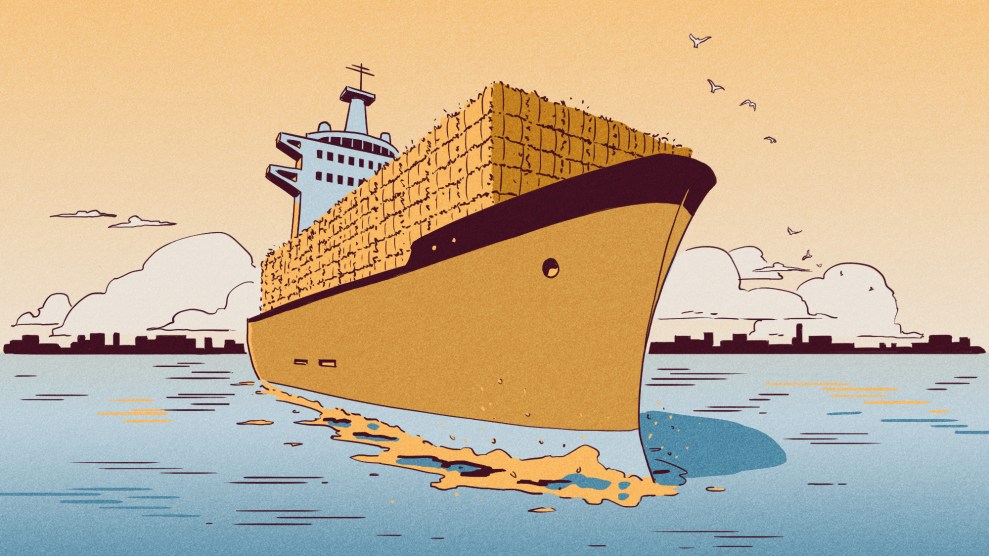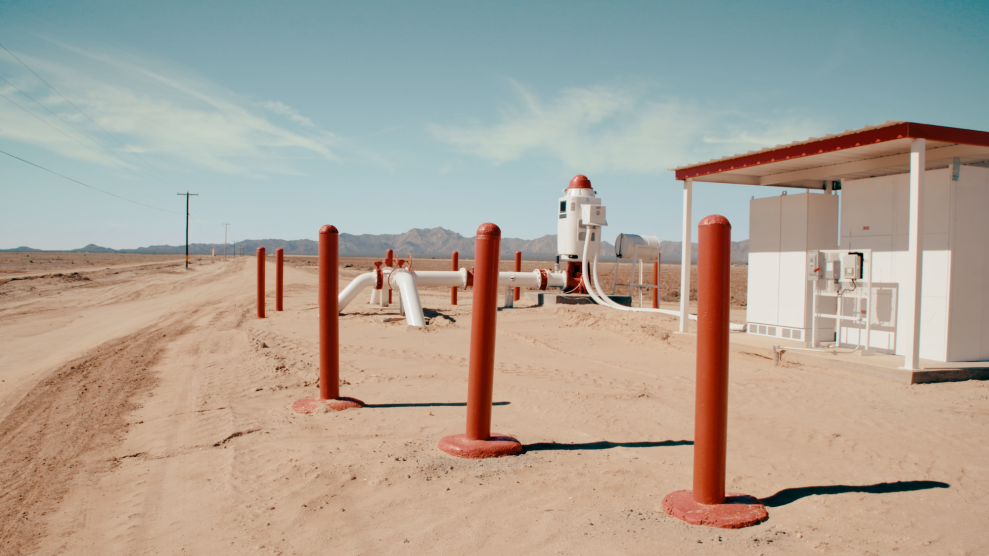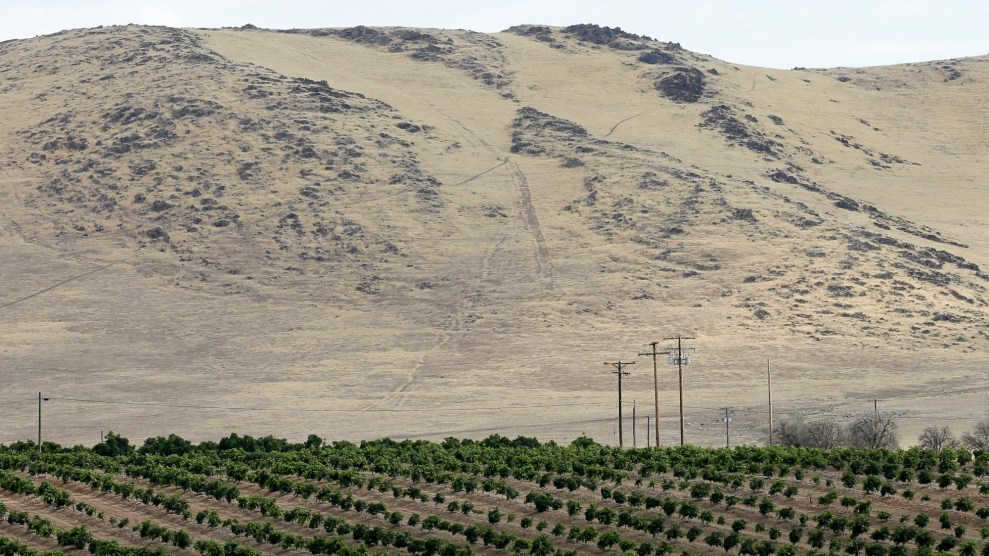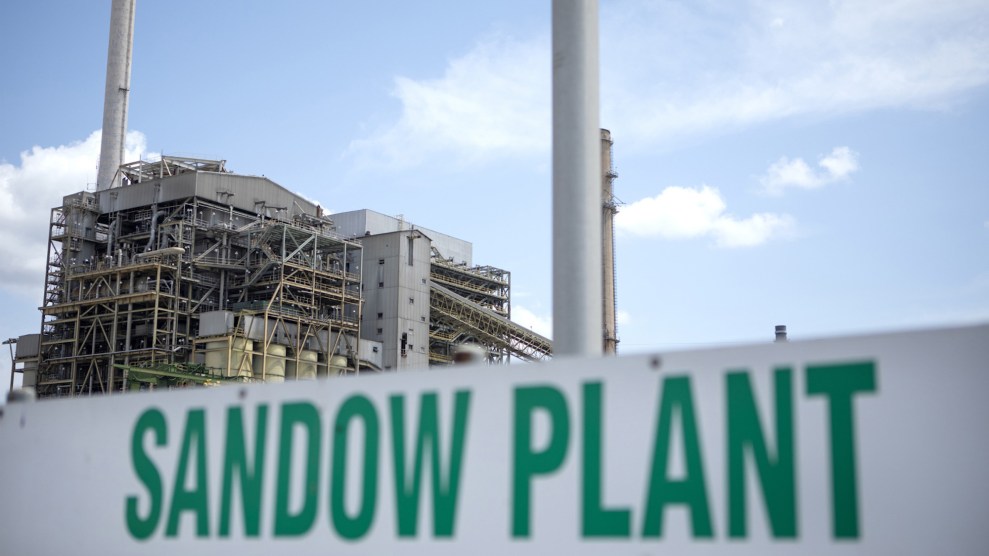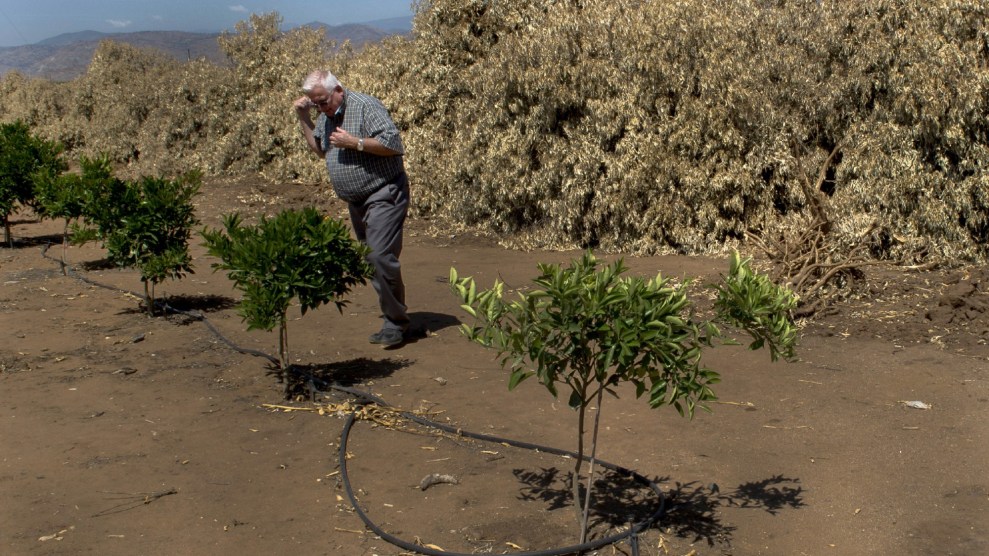
David Roth, President of the Cecelia Packing, in front of a new orange crop after the Central Valley region's catastrophic water shortages.Renée C. Byer/ZUMA
This story was originally published by Inside Climate News and is reproduced here as part of the Climate Desk collaboration.
Groundwater supplies are dwindling in aquifers around the world, a groundbreaking new study found, with the rates of decline accelerating over the past four decades in nearly a third of aquifers studied.
Many agricultural centers face an uncertain future as a warming climate threatens water availability around the world. Groundwater has long acted as a climate buffer, providing a source of freshwater for communities with unreliable rainfall. But human activity has unleashed a feedback loop that is placing this crucial resource at risk: decades of uncontrolled combustion of fossil fuels has caused more frequent and severe droughts, which in turn has led to increased reliance on groundwater.
In California, growers treated underground aquifers as unlimited sources of water until the state finally started to regulate groundwater a decade ago. By then, unfettered pumping had already left more than 20 of the state’s groundwater basins—lifelines for many community drinking water systems—“critically overdrafted.”
The new research, reported Wednesday in the journal Nature, shows that California is hardly alone in failing to safeguard a critical resource.
Declines were most prevalent, and dropping fastest, in drier regions with extensive agriculture, an international team led by researchers at the University of California, Santa Barbara, and ETH Zürich found by analyzing satellite data in combination with individual monitoring wells in more than 40 countries. Irrigation accounts for about 70 percent of global groundwater withdrawals, and the researchers found that rapidly declining groundwater levels were “virtually absent” in uncultivated lands.
Still, the news is not all bad. Long-term groundwater losses are “neither universal nor inevitable,” the team notes.
“Rapid and accelerating groundwater declines are, unfortunately, widespread globally,” said Scott Jasechko, a water resources expert at UC-Santa Barbara who co-led the study. “But we also find cases where declining groundwater trends have been reversed following clever interventions.”
In nearly half of the cases reviewed, groundwater levels that had been declining either slowed (20 percent), reversed their decline (16 percent) or rose (13 percent). Reversals were largely a result of implementing policies or regulations that turned to alternative sources like recycled water or diverted river flows, used tiered or higher fees for water consumption or intentionally replenished, or recharged, aquifers with water from other sources.
The research builds on previous work by Jasechko and Debra Perrone, a UC-Santa Barbara water sustainability expert who also contributed to the Nature paper. In the earlier study, published in Science, they analyzed the depth of nearly 40 million groundwater wells that supply households and farms around the world. They found that millions of wells were so shallow—penetrating just 5 meters, or 16.4 feet, into the groundwater—they could run dry with even modest drops in groundwater.
“We’re already seeing clear evidence of wells running dry impacting communities and families in California’s southern Central Valley,” said Jasechko, referring to one of the richest agricultural regions in the world.
One motivation for this project, he said, was to put the California groundwater declines into a broader global context. So the pair joined other leading water experts to get a handle on changes in groundwater levels over time by reviewing measurements taken at wells used only for monitoring.
They started with some 300 million water level measurements from 1.5 million monitoring wells and determined aquifer boundaries from previous studies. But to detect a trend, they needed a minimum of two measurements during the 21st century, separated by at least eight years. That left them with 170,000 wells in nearly 1,700 aquifers worldwide—the largest dataset ever compiled at such a local scale.
The analysis shows that rapid groundwater level declines of a half a meter per year (about 1.6 feet) are widespread, Jasechko said. “And what that means practically, in places where wells are no more than five meters below the water table, is that those wells would run dry within the next decade if groundwater levels continue to decline at half a meter per year.”
They also found that rates of groundwater level declines in some areas in the southern portion of the Central Valley and the adjacent Cuyama Valley are among the highest in the world, Jasechko said.
Aquifers in India also showed serious declines, along with less studied regions, including an agricultural center in Iran, the West Qazvin plain.
“They’ve done a really nice job of pulling together a lot of disparate data sources to shine a light on this issue,” said Ellen Hanak, a senior fellow with the nonprofit Public Policy Institute of California’s Water Policy Center who was not involved in the research.
The study provides insights at a local level that are going to be really helpful for folks looking at groundwater issues in many different parts of the world, Hanak said.
Previous studies have looked at groundwater depletion on a global scale, but they relied on satellite or modeling data, which doesn’t reveal real-world conditions at the local level. Jasechko’s team also used satellite data to glean insights into sites that lacked data on individual wells, drawing on satellites deployed as part of a NASA-German collaboration called the Gravity Recovery and Climate Experiment, or GRACE, mission. Because fluctuations in water levels can affect gravity, scientists can use satellites that detect changes in Earth’s gravity to track large-scale underground water dynamics.
One of the contributions of this paper is the incredible global data set the team pulled together while also highlighting gaps, said Donald John MacAllister, a groundwater specialist at the British Geological Survey who reviewed the paper. “There are still large parts of the Earth’s surface that it doesn’t cover.”
The study covers about three-quarters of global groundwater withdrawals, including all the significant removals, with India, Pakistan and the United States among the biggest, MacAllister said. But there are significant gaps in China, which is a “massive user of groundwater,” he said. “And then there are really large gaps in Africa, where I think groundwater is going to be crucial in the future for climate resilience and response to drought, and also in South America.”
That said, he added, “this type of global analysis hasn’t really been done before.”
Data were either inaccessible or missing from some countries, said Richard Taylor, a professor of hydrology at University College London who contributed to the new study. But there is also quite a bit of information in some places he visits often, he said, like tropical Africa. It just doesn’t exist in the form they needed for the study.
Having data over a longer time frame has the advantage of allowing scientists to understand how groundwater responds to both climate change and human use, said Taylor, who specializes in ensuring access to drinking and irrigation water in low-income tropical countries.
And in many places where information from individual wells wasn’t available, evidence from satellite observations and modeling studies suggests that groundwater declines may be even more widespread than the team could confirm.
“I think one promising pathway for future research would be to bring together the strengths of the satellite-based technologies like GRACE and the strengths of the locally relevant groundwater level observations that we are reporting on here,” said Jasechko.
Unlike satellite-based observations, information from monitoring wells is linked to individual aquifers, said Taylor. That means people can take action because they now have information on precise locations. It also shows that the detail matters, he said. “One of the surprises for us is that you have side-by-side aquifer systems that are depleting and that are recovered.”
That raises the question of why one aquifer system—which consists of one or more connected aquifers—would be draining and one recovering in places with similar agriculture, climate and geology, Taylor said. “Equipped with that kind of information, it becomes a little less doomsday-ish and a little bit more, hey, we can do something about this.”
Roughly half the world’s people, including about 145 million Americans, get their drinking water from groundwater.
Groundwater offers a level of resilience that you don’t get with surface water, MacAllister said. “As we have climate change, and increasing drought and extreme rainfall, surface water responds almost immediately, whereas groundwater is buffered from that.”
Groundwater hasn’t yet been developed as a resource in many parts of the world but is clearly needed, he said, pointing to East Africa, which is dealing with a six-year drought.
And though the new study provides a bleak picture of the precarious state of a resource that billions of people depend on, MacAllister said, it’s important to recognize places where solutions have turned things around.
A region in Saudi Arabia, for example, appeared to stem the speed of its losses with policies that reduced agricultural demand. The Abbas-e Sharghi basin in Iran managed to reverse declines toward the end of last century by diverting water from a nearby dam, while Tucson, Arizona, reversed declines with aquifer recharge projects that replenish groundwater by putting water from other sources into basins, where it seeps back into the aquifer.
Learning from these types of measures will become increasingly important as agricultural areas see changes in water availability, especially in regions destined for more frequent and more severe droughts.
“We found that in more than 80 percent of the places where groundwater declines accelerated, there was a reduction in total precipitation over the last 40 years,” Jasechko said. This relationship, he added, “is hinting at a connection between climate variability and groundwater level change.”
Changes in precipitation can exacerbate demands on groundwater.
Say a farmer typically irrigated crops with surface water fed by snowpack that melted from April to August, Taylor explained. Then a shift in precipitation from snow to rain not only reduced snowpack but changed the volume and delivery of its meltwater so that all the water is gone by May.
As a result, downstream farmers who previously relied on surface water for irrigation are now using groundwater in June instead of September, Taylor said. “It creates a kind of greater dependency on the groundwater resources as your source of irrigation.”
It also raises the question of crop selection, he said. “Why are we raising very water-intensive crops in an area that hasn’t got much water?”
Taylor points to an inspiring success story in west central Bangladesh, one of the country’s poorest regions with the most severe groundwater depletion. They were able to replenish their groundwater by switching from rice to wheat along with an aquifer recharge scheme, he said.
He acknowledges that it’s a challenge to tell people to stop growing crops their livelihood depends on. But if growers in a region that was the fourth-largest producer of rice in the world can change, it offers lessons for growers in places like California, he said.
For Hanak of the Public Policy Institute of California, the study raises the question: what do the trends the authors found portend? In some places, it will be possible to find water to use as substitute supplies or to replenish aquifers, she said, and in some places it won’t. The challenge is likely to be greatest in agricultural regions where a changing climate is reducing availability.
“There will be a reckoning one way or another,” Hanak said. That might come through management rules that reduce allocations or through water levels dropping so low that it becomes too expensive to keep pumping.
Jasechko hopes the study inspires scientists, policymakers and groundwater managers to act on the findings.
“Groundwater is one of our best buffers against climate variability and change in the future,” said Jasechko. “Managing it wisely is in our best interest, given the inherent uncertainties of what comes next.”
